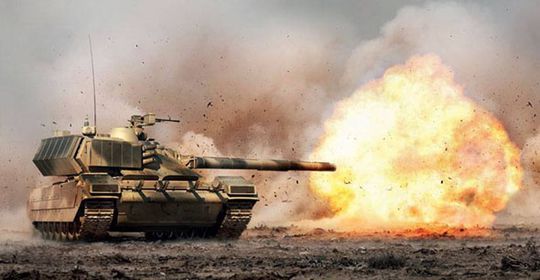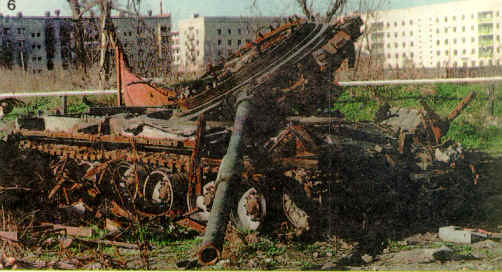
Not only in the context of the Crimean crisis puts Moscow on steel: From 2015, the T-99 the "Armata" -Fahrzeugserie to be introduced as a standard battle tank. Its construction will be partially completely new.
Against the backdrop of simmering crisis over the Crimea and Ukraine, in the face of other potential "hotspots" in Eastern Europe (eg the Baltic states, Moldova) and the ongoing de-militarization of Central Europe receives the unexpected relevance: Later this year, it will decide whether a new Russian armored project ready for series production, namely the battle tank T-99th Which should be part of a whole vehicle series that will operate under the name "Armata". In the best case, the first deliveries could begin at the Russian army already 2015 - by 2020, it is said, to about 2,300 T-99 will be built.
"We'll go over to the new research and development phase, to be completed by 2015," had Vyacheslav Khalitow, Deputy General Director of Heavy Industry Group Uralvagonzavod, said in the fall. Series production is scheduled for 2016. Three Armata prototypes are being tested, recently confirmed the British magazine "Jane's Defence" that Uralvagonzavod - the Group has its headquarters in the 360,000-inhabitant city Nizhny Tagil in the Sverdlovsk district in the Urals - already started full of the trials have
Tower without crew
About the T-99, a position which at least one Russian insiders since last fall has to be well known, yet nothing definite is known abroad as such. So much has transpired, it will be a vehicle of trade around 50 tons, powered by a diesel engine in the 1400- to 1600-horsepower range and a 125-mm smoothbore gun predominantly newly developed 32 Shot in the magazine and fully automatic loading system can also burn the anti-tank missiles to. The speed should be 80 km / h for more than 500 km range.

T-99 (Illustration) / image: armyrecognition.com
Novel, especially the construction of the tower will be: This is the central module for all battle tanks usually sit two to three crew members (commander, gunner and optionally a load contactors); but the tower of the T-99 should remain unmanned, it is complete with gun (and at least a coaxially mounted rapid-fire grenade launcher caliber 30 to 35 mm and a MG) remotely, from the trough of the carapace. This is the entire crew - commander, gunner, driver - like sitting in a bunker, and because of the unmanned tower can be built much flatter than usual and therefore will be easier, the tub can be armored for even more than usual. The flat tower also lowers the height of the tank and makes it a smaller target.
A whole series vehicle
Air conditioning systems (in Russian tanks long anything but usual) and active protection systems approaching anti-tank missiles (such systems work with proximity sensors and hurl missiles about splinters clouds and explosive charges against) will probably be available.

Alleged elevation of the T-99 / image: armyrecognition.com
Another special feature is the design of the Armata system itself (Armata is the plural of the Greek word for "chariot"): It is as mentioned to the base of a complete vehicle series about even armored (working name "Kurganets 25"), artillery pieces, may include flamethrower tanks, anti-aircraft tanks and armored recovery vehicles;because all of these vehicles have the same chassis, production and maintenance much easier and cheaper. Armata therefore also runs under the name "Universal Fighting Platform".
Armata has therefore of crucial importance for the Russian arms industry and the military, because since the commissioning of the most modern Russian battle tank T-90 series in the early 1990s two large tanks announced projects are asleep again. The T-95 (officially "Object 195") had as special features also should get a remote tower and a hydro-pneumatic suspension similar to the French "Leclerc", to an unusually large and powerful slamming caliber gun 152 mm (in the west are 120 mm default).

Graphic of a T-95 / image: Vulcan Raven / wikipedia
But in May 2010, the Department of Defense emphasized the financial means for the tanks, mainly because kampfwertzusteigern general savings in the military field and the decision to T-90.
The black eagle flew close
Something similar happened to "Object 640" and "Black Eagle" and called in the West T-2000: This vehicle the company "Omsktransmash" in Omsk (Western Siberia), the end of the 1990s it became known was mainly due to its ultra-slim tower with a semicircular , fan-shaped add-on armor on the front and a new automatic loader on the rear panel. There were also rumors of a radar-absorbing coating.

Prototype of a black eagle / image: doppeladler.com
The company went bankrupt in 2002, Uralvagonzavod took over the development department and military construction rights, but pursued the project also because of his own T-95 no further; Export customers like Iran and Cyprus had shown no interest.
Uralvagonzavod (the name means Uralwaggonwerk) was built in the 1930s as a wagon factory and advanced rapidly to excavators, tractors, other vehicles, various metal alloys, consumer and just tank and mechanized vehicles. During World War II, the company was merged with several other armored units and the largest tank producer in the world, here ran until 1945 alone, more than 30,000 copies of the famous T-34 from the tape of that tank, which, by its very number of the war in the East in favor of the USSR decided.
Largest tank builder in the world
Even today, the company is the world's largest tank manufacturer and is said to have achieved in the past few years alone with the T-90 about 15 to 20 percent of their sales. At least 1,660 units were built since 1991 and most of them exported to India and about Algeria. In India, T-90 variants are also manufactured under the name "Bhishma" licenses.

Indian T-90 (Bhishma) / Photo: flickr / wikipedia
The future T-99, however, Russia might well replace a substantial part of its active tank fleet. Their size is not uniform way, given by experts worldwide, mainly because of the fact that Russia has incorporated many thousands of older tanks models - with more or less likely to reactivation, many are only good for parts.Probably not even know the Russians themselves exactly how many tanks they have - but overall, no other country has so many battle tanks such as Russia.
Reasonably reliable figures are as follows: Approximately 740 T-90 and 2200 mostly combat performance increased T-72 are divided into the active tank units.
4500 T-80, however, were incorporated gradually in recent years, the last only last December. The T-80 had in the Chechen wars of the 1990s heavy losses, mainly because they were used tactically wrong: They drove without sufficient infantry escort directly to cities where they were destroyed by melee fighters with rocket-propelled grenades, incendiary devices, mines and the like rows.

Destroyed T-80 in Grozny / image: vietnamdefence.com
More up to 8000 T-72 are in the reserve, as well as about 4,000 old T-64, even 850 T-62 and 1200 but really now obsolete T-55th Several hundred of the T-64 and T-62 are however still be in active associations, presumably for training, or purely in the role as assault guns for infantry support. It comes in theory at least on total numbers of more than 21,000 battle tanks, probably a third of them are no longer suitable for use.
The scattered armored forces of NATO
A substantial part of the armored units stationed at the southern borders of the Caucasus and Central Asia, and with China. In the west (ie NATO) are the after many years of total disarmament somewhat weaker (that they were relatively speaking, of course, even during Soviet times), but especially regionally fragmented armored forces opposite.
France about currently has only about 400 battle tanks Leclerc, United Kingdom about the same number of Challenger, Poland about 750 different types (trend rapidly decreasing), Germany 350 Leopard II (percentage decreasing, but apparently 1000-1500, including Leopard I in reserve) , Halfway larger European NATO countries such as Italy and Spain bring just been about 320 per battle tanks together, minor, such as Denmark and Norway, 50 to 60 per; some have their battle tank units even largely to completely abolished: as Hungary (32 to 130 in reserve, but declining), Belgium and the Netherlands (both 0).

Return of the Abrams to Grafenwoehr / image: Stars and Stripes
The United States, however, have essentially about 6300 Abrams tanks, many of them mothballed. From Europe (mainly from Germany) once strong US armored divisions were withdrawn after the end of the Cold War, however, in the spring of 2013, the last Abrams were shipped across the Atlantic. This February 29 pieces but came back: They serve for training and maneuvers on the Grafenwoehr Training Area in the Upper Palatinate
http://diepresse.com/home/politik/a...Russland-feilt-an-revolutionaerer-PanzerSerie
